 |
| ベニト石ルース(Faceted benitoites) 0.12 - 1.18ct |
ベニト石(Benitoite)
 |
| ベニト石ルース(Faceted benitoites) 0.12 - 1.18ct |
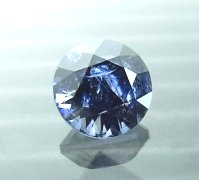 |
 |
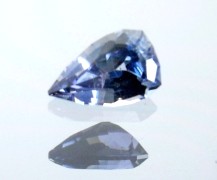 |
 |
 |
 |
 |
 | ||||
| 1.18ct Ø5.9mm | 0.88ct 6x5.6mm | 0.84ct 7.5x4.7mm | 0.57ct 4.9x4.6mm | 0.12ct Ø3.2mm | |
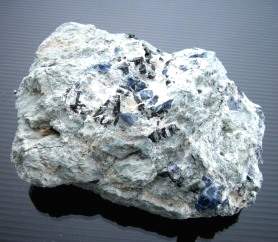 |
 |
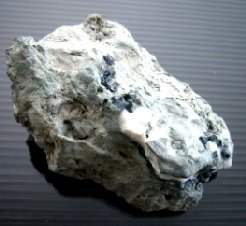 |
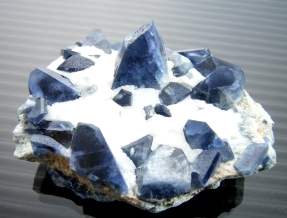 |
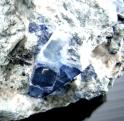 | |||
| 140x110x60mm | 85x54x38mm | 46x32x24mm | |
 |
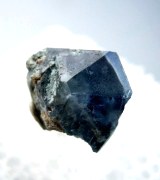 |
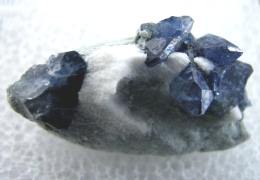 |
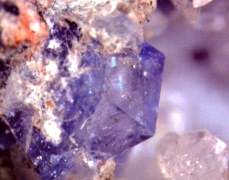 |
| 12.5x12.5x2mm | 10x9x7mm | 24x13x12mm | 新潟県糸魚川市青海のベニト石 高さ(H) 3mm 宮島コレクション Benitoite crystal from Ohmi, Japan |
| Benitoite Gem Mine | |||
| 化学組成 (Composition) |
結晶系 (Crystal System) |
結晶形 (Crystal Forms) |
モース硬度 (Hardness) |
比重 (Density) |
散乱 (Dispersion) |
屈折率 (Refractive Index) | ||
| BaTiSi3O9 | 三方晶系 (Trigonal) |
 |
 |
 |
6 - 6½ | 3.64-80 | 0.044 | 1.757-805 |
 |
 |
 | ||||||
ベニト石の発見の逸話(Benitoite's discovery)
ベニト石は1907年2月にアメリカ・カリフォルニア州・サン・ベニト郡ディアブロ山脈南部のイドリア地区、標高1370mの地で発見されました。
銅や水銀を探査中のジム・カウチがキャンプの朝、サン・ベニト川の源流の畔、白く風化した石の間に何千もの青い宝石がガラスの破片のように煌いているのを発見したのです。
鉱物に詳しいカウチはこの宝石をサファイアと考えました。が、最初にこの石をカットした研磨工はサファイアにしては柔らかすぎる青い色の石をスピネルと判定し、またロサンゼルスの宝石専門家は火山ガラスと断言しました。
がサン・フランシスコ最大の宝石店の支配人、アーチャー・エクレットはこの石が強い副屈折を示すことから、カリフォルニア大学・バークリー校の鉱物学教授のジョージ・ラウダーバック博士にサンプルを届けました。
博士はこれが新種の鉱物であると認めました。そして鉱山に赴いて新発見を確認し、発見された土地に因み新鉱物をベニト石と命名すると共に論文を発表しました。
この論文により77年前の1830年にドイツの鉱物学者、ヨハン・ヘッセルにより予言されていた両三角の両錐形という特異な結晶形を持つ鉱物の存在がようやく確認されたのでした。
Benitoite was first discovered in 1907 at 1370m elevation of Idria District, southern Diablo Range, San Benito County, California, U.S.A. Early February morning, copper and cinnnabar prospector Jim Couch noticed little flashes of light resembling reflections from broken glass, glancing across the tiny brook. Upon investigation he was astounded to see "thousands of blue gems" scattered about the hillside where they had weathered out of a snow-white material later identified as natrolite. He first thought that was sapphire. While an expert from the Los Angeles area proclaimed the new material "volcanic glass", a lapidary called the stone spinel : "It was too soft for a sapphire, so it must be a spinel, since that's the only other stone there is of that color. The lapidary showed some of the stones to George Eacret, the manager of Shre v & Co., one of the largest jewelry stores in San Francisco at that time. Eacret checked the stone and found that it was doubly refractive, so he delivered a sample to Dr. George Louderback, a mineralogist at the University of California (Berkeley) who determined that it as a new, undescribed mineral. In the company of Mr. Eacret, Dr. Louderback made his first visit to the mine on July 19, 1907, and confirmed the discovery and named the new mineral "Benitoite" upon the locality it was first discovered. He then descrived full-length article. His documentation of the ditrigonal-dipyramidal crystal habit finally proved the natural exsistence of the crystal form, which had been predicted mathematically 77 years earlier in 1830, by German mineralogist, Johann F.C.Hessel.
ベニト石の産状と特徴(Benitoite occurences and characteristics)
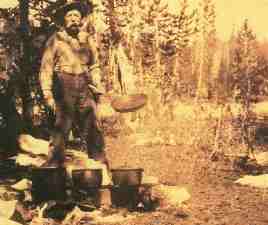 |
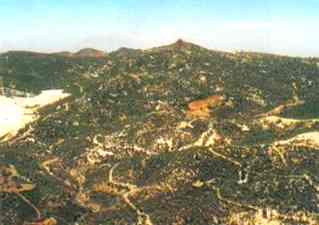 |
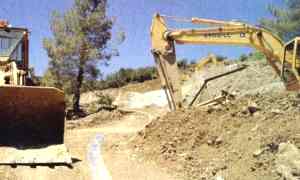 |
| ベニト石の発見者ジム・カウチ Jim Couch at a campsight near Benitoite mine |
ベニト石の鉱山(褐色の露頭)遠望 Benitoite Gem mine workings (small brown cut) |
2000年初頭の鉱山 Mine works in early 2000 |
| Photo : Dallas Mining Company archive | Photocourtesy: Kennecott Exploration Company |
ベニト石の発見以来、その成因は永らく謎でありました。
チタンとバリウムと言う特異な成分を含む鉱物の成因としては基本的に熱水起源を前提として様々な説が提唱されました。
この地域の地質と化学的な成分分布等とに基づいて現在考えられている説は : 地殻変動により蛇紋岩の接触変成作用が起こった際に、風化した青色片岩と恐らくグリーンストーンとに含まれていたバリウムとチタンが、貫入したマグネシウムとカルシウムに富む熱水と反応してベニト石が生成されたという考えです。
ベニト石は自然の鉱物の中では屈指の高い複屈折を示します。またダイアモンドと同じ0.044と言う高い散乱を示します。
このため冒頭の写真のように無色、或いは淡い色の石はダイアモンドのような強いファイアーを示します。
さらに如何なる結晶軸の方向にも劈開性を持たず、モース硬度が6と言う適度な硬さを持つためにカットが最も容易な鉱物の一つです。
と、化学組成、結晶形、光学特性等々、多くの特異な特徴を持つ極めて稀な鉱物です。
世界でたった一ヶ所からしか採れない世にも稀な鉱物が偶々サファイアのような宝石であったと言う奇跡にはただただ感嘆するのみです。
Ever since benitoite's discovery, its origin has been a persistent enigma. The formation of benitoite at the New Idria district has been genrally ascribed to hydrothermal processes that caused the unusual combination of barium and titanium. Today, the most convincing idea is as follows : Benitoite formed at the Benitoite Gem mine when Ba and Ti were released by the alteration of blueschist, and possibly greenstone, in the presence of magnesium-and calcium-rich fluids generated during the regional metamorphism of serpentinite. This model is based on detailed geologic mapping and the collection of chemical data on blueshcist minerals and whole-rock samples at all the known benioite occurerences in the district.
Benitoite is is one of the easiest gemstones to facet. There are no directional weaknesses(e.g., cleavage). Benitoite has unual optical characteristics ; extremely high birefringence of 0.047 and high dispersion of 0.044.
世界のベニト石産地(Worldwide occurence of benitoite)
ベニト石は同じカリフォルニアのフレスノ郡、テキサス州の Eocene Cook山、アーカンサス州の他オーストラリアBroken Hillの花崗片岩中, 日本の糸魚川流域の青海、金山谷川の蛇紋岩中の曹長石ー角閃石中等、世界の9ヶ所にて発見されています。しかしいずれも微細な鉱物標本が稀に発見されるのみです。
実質的にはサン・ベニト郡が世界で唯一の産地と言えるでしょう。
この産地では10kmの範囲の地域に5ヶ所の鉱床が発見されていますが、宝石級の美しい結晶の産出は質、量ともに Benitoite Gem Mine のみ。5kmほど離れた Junnila 鉱区から表面が溶融された結晶を産出し、その宝石質部分から小さな0.5ct以下のルースが僅かな量カットされることがありました。
主力の Benitoite Gem Mine にしても産出量は極めて少量でしかありませんでした。
Benitoite has been confirmed from nine locations around the world, but only the historic Benitoite Gem mine and the Junnila claim have produced gem-quality material. All of the commercial gem production has come from the Benitoite Gem mine. At the three other deposits in the New Idria district, benitoite has been found only as small, platy(non-gem quality) crystals, up to a few millimeters in diameter.
Outside the New Idria district, benitoite has been found in situ at four areas. AT Big Creek-Rush Creek - in the Sierra Nevada foothills of eastern Fresno County, California - small grains of benitoite are found in gneissic maetamorphic rocks near a type of igneous rock known as granodiorite. This occurence is located nealy 160km northeast of the Benitoite Gem mine, and is not geologically related to the New Idria distric. In Japan, benitoite was notee from albite-amphibole rock in a serpentinite body, along the Kinzan-dani River, at Ohmi in the Niigata Prefecture. At Broken Hill, New South Wales, Australia, benitoite was reported as a rare mineal in hig-grade granite gneiss. Most recently, crystals of colorless, blue, and pink benitoite averaqging 1-2mm in diameter were detected in gas cavities in syenite at the Daimond Jo quarry inj Hott Springs County, Arkansas. Detrital grains of benitoite were recovered from Pleistocene lake sediments at the Lazzard estate, few kilometers west of Lost ills, in the San Joauin Valley, Kern County, California.
ベニト石ルース生産量情報(Faceted benitoite)
1907年の発見から1967年の60年間に凡そ2500カラットのルースが生産されたと推定されます。内1000カラットが1907年から1911年の間の産出です。スミソニアン博物館所有の7.6カラットの石はこの時のものです。大半は1カラット以下の石でした。 1911年と19067年の間に1500カラットのルースが得られたと考えられます。1967年から97年までの30年間にカットされたベニト石は僅かに2000カラットにすぎません。そのうち、大きさの内訳は0.25カラット以下が2000個、0.25〜1カラットが1500個、1〜2カラットが500個、2〜3カラットが50個、3〜4カラットが25個、4カラット以上は僅かに15個でした。その他おそらく500個程度が結晶からのカット等、別ルートから流れたと推定されます。
そんなわけで2005年に鉱山が閉山するまでの凡そ1世紀の間に生産されたベニト石は全てを足し合わせても5000カラットでしかありません。この極端な稀少さのためにベニト石が宝飾品市場に流通することは無く、限られたコレクター向けの宝石でありました。したがって値段は1カラットのルースが30年前で1000ドル、閉山となった後の現在でも1600ドルと、超稀少な宝石としては異例の妥当な水準です。
The Benitoite Gem mine is the only commercial source of gem-quality benitoite in the world. From the time of its discovery in 1907 until 1967, it is estimated that about 2,500 carats of faceted benitoite were produced. Of that amount, nearly 1,000 carats were produced during the period of active mining between 1907 and 1911. It was during this time that 7.6 carat stone , now in the Sithsonian Museum was faceted. Few other stones exceeded 3 ct, however, and most of the gems weighed less than 1 ct. The balance of 1,500ct believed to have been recovered between 1911 and 1967. Since 1967 till 1997, approximately 2,000 carats of benitoite were faceted : 1) 2,000 pieces, generally less than 0.25ct, 2) 1,500 pieces between 0.25 - 1 ct, 3) some 500 stones between 1 and 2 ct 4) a total of 50 stones between 2 and 3 ct, 5) only 25 stones between 3 and 4 ct, 6) the 15 largest stones exceeded 4 ct. And 500 carats of finished goods are estimated to have entered the nmarket through informal channels, such as the cutting of older rough and the faceting from mineral specimens.
Thus a total of about 5,000 carats of faceted benitoites have been produced over the life of the mine, which finished the mining in 2005.
Because of this small production, benitoite has been a collector's gem, one of the rarest in the world. And the price level has been quite reasonable for the rarity, USD$1000 in early 1980's and today US$1600, even after the closure of mine in 2005.
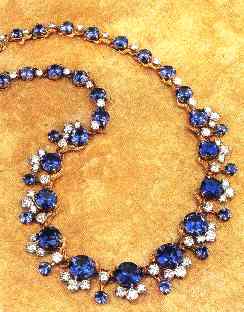 |
 |
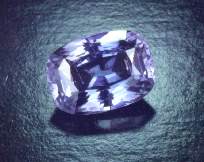 |
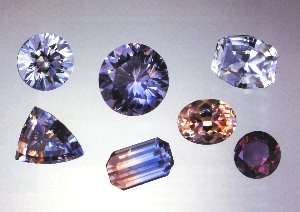 |
| 最大2.84ctのベニト石52個(合計33ct) を使用したネックレス (A necklace with 52 benitoites) |
史上最大のベニト石 15.42ct (The largest benitoite) |
7.6ct 14.5x10.5x8mm |
珍しい無色、紫、多色の例 0.34−1.29ct (Rare benitoite's color variations) |
| Michael Scott Collection | Smithsonian Collection |
ベニト石の色(Benitoite coloration)
サファイアのような色合いのベニト石の発見以来、その発色の原因については無数の説が提唱されてきました ; 命名者ラウダーバックによるチタン還元説、コールマンによるヴァナジウム、ニオブ、銅の不純物説、レアードとアルビーの鉄の不純物説、バーンズ等の酸素原子に拘わる結晶欠陥説、同じくバーンズによるFe2+→Fe3+電荷移動説、ミレージによる金属ー金属電荷移動説やチタン側のジルコニウム説等々、ありとあらゆる説が唱えられましたがいずれも否定されています。
ベニト石の青い色の発色の原因は未だに未解明のままです。
ベニト石の大半は青ー紫でごく稀に無色のものがあります。写真のピンクー橙の発色は加熱処理によるものです。
Because of sapphire-like color, numerous investigators have attempted to link the chemical composition of benitoite to its coloration. Louderback(1907) initially attributed the blue color to traces of reduced Ti. Coleman(1957) suggested that trace impurities of V, Nb, and Cu might cause the blue coloration. Laird and Albee(1972) noted slightly higher concentrations of Fe in blue than in colorless benitoite. Burns et al.(1967) suggested that the coloration is caused by crystal defects due to an oxgen deficiency. Burns(1970) suggested that the pleochroism of benitoite and other minerals might be caused by Fe2+→Fe3+ charge transfer. Millage(1981) also proposed metal-metal charge transfer, such as Fe2+→Ti4+ or Fe2+→Fe3+, as a coloring agent. He also attributed the blue coloration to traces of Zr in the Ti site. In spite of much effort to interprete the spectral data, the cause of color in benitoite remains elusive.
Most of natural benitoite is blue-violet and rarely colorless. Orange and pink colors are due to heat treatment.